If you’re planning a visit to Organ Pipe Cactus National Monument, this guide will help you make smart choices about timing, routes, and safety. You’ll learn how big the park is, costs, camping options, best scenic drives and hikes, and what wildlife and plants to expect. Practical tips will keep you prepared for desert conditions and nearby services in Ajo — and there’s one key seasonal detail you won’t want to miss.
How Big Is Organ Pipe Cactus National Monument?
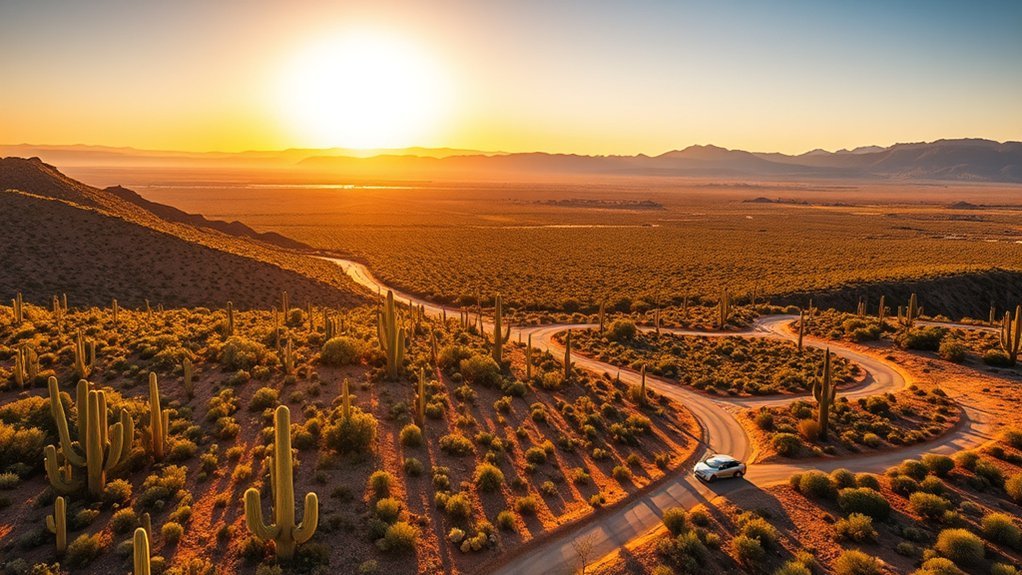
Covering roughly 516 square miles (more than 330,000 acres) of the Sonoran Desert, Organ Pipe Cactus National Monument protects an immense and rugged landscape that’s been set aside for conservation since 1937. You’ll find that the scale is remarkable: over 95% of the area is designated Wilderness, so you’re looking at vast, largely undeveloped tracts that shelter more than 2,000 plant species and roughly 300 bird species. The park is a UNESCO Biosphere Reserve, underscoring its biodiversity and ecological importance. Organ Pipe Cactus National is the only U.S. location where the organ pipe cactus grows abundantly, and the National Monument offers a unique landscape of cacti-studded bajadas, desert washes, and rugged ranges you can explore with respect for protection measures.
When to Visit and Weather Considerations
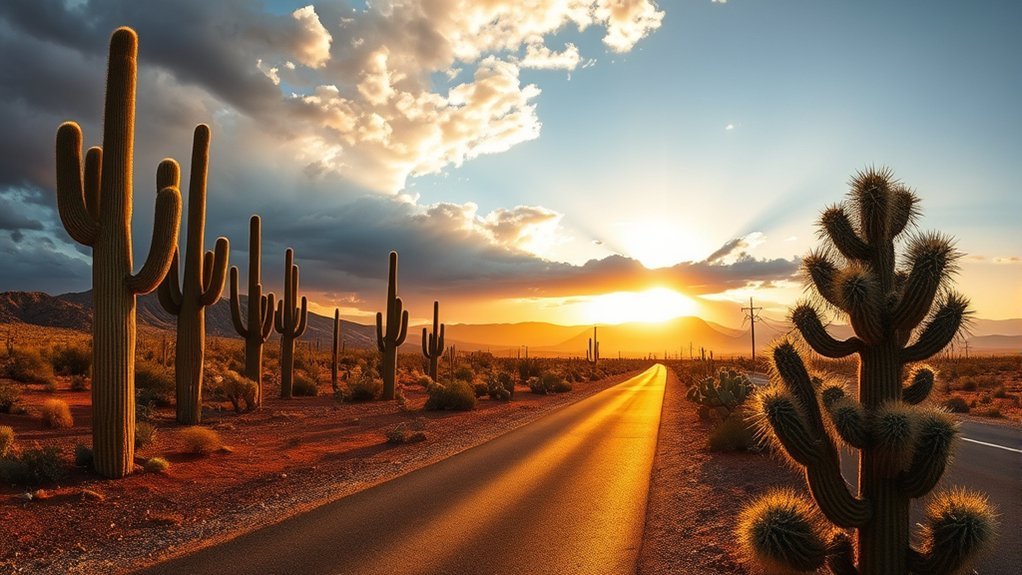
Plan your trip for December through March when daytime temperatures are mild and the desert is most comfortable for hiking and photography. Remember nights can get much cooler, especially in winter, while summer heat often exceeds 100°F and creates serious hazards. Because the monument is remote, you should check forecasts, pack for big temperature swings, and be ready for sudden weather changes.
Best Months to Go
If you want mild weather and the best conditions for hiking, visit Organ Pipe Cactus National Monument between December and March, when daytime temperatures are comfortable and trails are easy to enjoy. Those are the best months to go for reliable, pleasant conditions; you’ll avoid summer heat that often exceeds 100 degrees Fahrenheit and limits outdoor activity. Spring brings wildflowers in March and cactus blooms in May–June, so plan accordingly if blooms matter. Always carry water and sun protection.
- Winter (Dec–Mar): ideal temperatures for hiking and exploring.
- Spring (Mar–Jun): blooms peak—March wildflowers, May–June cactus blooms.
- Summer (Jul–Sep): extreme heat; not recommended for strenuous hiking.
Daytime Vs Nighttime Temps
Most visitors find daytime temperatures from December through March comfortably mild — generally mid‑60s to low‑80s Fahrenheit — while summer highs often soar past 100°F, so you’ll want to schedule hikes for cooler months or early mornings in warmer seasons. Expect nighttime temperatures to drop sharply; evenings frequently fall into the 40s or 50s, so pack warm layers for post-sunset activities. Desert conditions change quickly, so check forecasts before you go and adjust plans accordingly. During daytime outings maintain proper hydration, use sun protection, and limit strenuous activity during peak heat. At night enjoy cooler air and stargazing but prepare for chillier conditions. Planning around these contrasts helps you stay safe and comfortable year‑round at Organ Pipe.
Weather Hazards to Watch
Because weather in Organ Pipe can swing from mild to dangerous, you should time visits for December through March when daytime highs are usually mid‑60s to low‑80s and risks from heat, flash floods, and dust storms are lowest. You’ll avoid summer heat-related illnesses and the worst of monsoon-driven flash floods. Still, treat the desert environment seriously: carry water, sun protection, and a plan.
- Summer hazards — Temperatures over 100°F raise risk of heat-related illnesses; avoid midday activity and know signs of heat stroke.
- Monsoon flash floods — Heavy summer storms can wash out roads and trails quickly; check alerts before you go.
- Wind and dust — Spring winds can produce dust storms that reduce visibility; delay travel when forecasts warn.
How Much Does It Cost to Visit Organ Pipe?
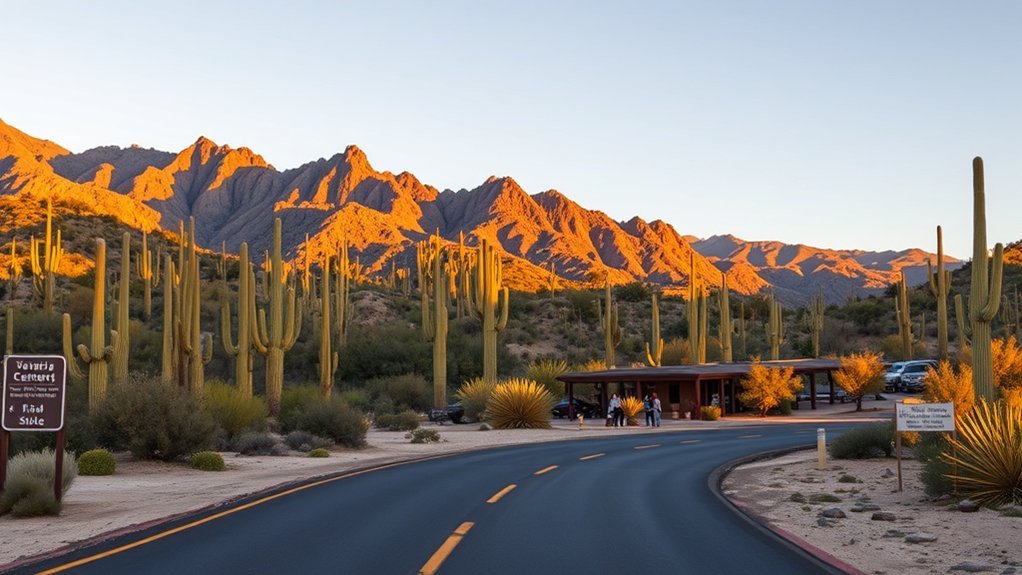
When you arrive at Organ Pipe Cactus National Monument, expect a $25 per-vehicle entrance fee that covers you for up to seven days; alternatively, an America the Beautiful annual pass costs $80 and grants access to this and other federal recreation sites. You’ll want to budget accordingly: the entrance fee is the primary cost for day visits, while the annual pass makes sense if you’ll visit multiple federal sites. Fees can change, so check the official website or call the visitor center before you go. If you need overnight options, note nearby camping rates vary — some primitive and free BLM sites exist — but detailed camping costs are covered elsewhere. Plan, verify current fees, and have payment ready at the gate or kiosk.
Camping and Overnight Options
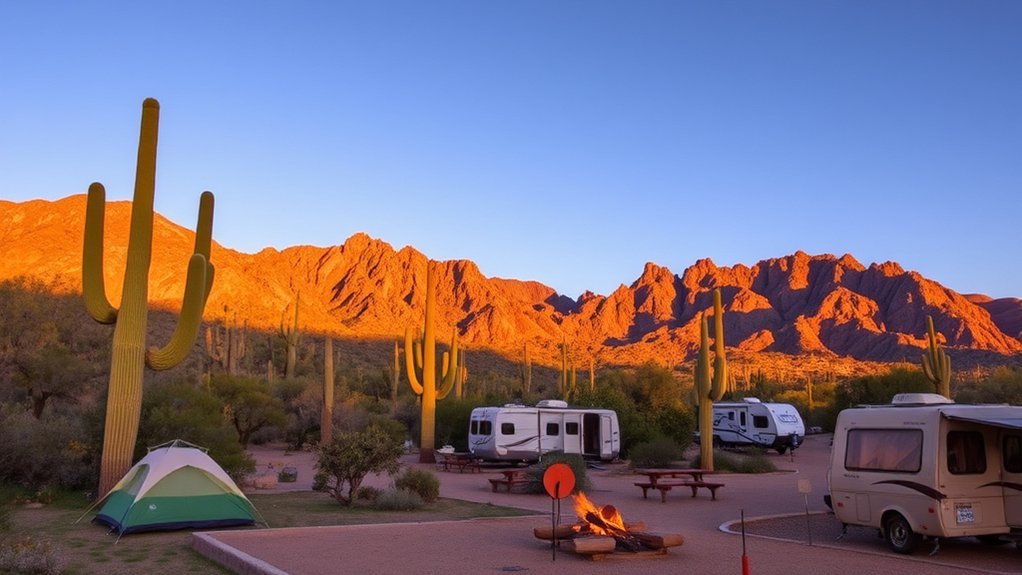
Camping at Organ Pipe Cactus National Monument gives you two on-site choices: the small, primitive Alamo Campground (four tent-only sites, $12/night) and the much larger Twin Peaks Campground (174 RV sites and 34 tent sites, $20/night), both with flush toilets, solar showers, potable water and an RV dump. You’ll find Alamo ideal if you want a primitive tent experience; Twin Peaks handles RVs and groups. Reservations aren’t required, so arrive early in peak season to secure a site. Nearby Gunsight Wash BLM provides free dispersed camping if you need alternatives.
Two on-site campgrounds—tiny, primitive Alamo or spacious Twin Peaks with RV services; nearby Gunsight Wash offers free dispersed camping.
- Pack for primitive tent camping at Alamo—bring water and shade.
- Use Twin Peaks Campground for RV hookups and larger parties.
- Consider Gunsight Wash BLM for free, dispersed options.
Scenic Drives and Best Routes
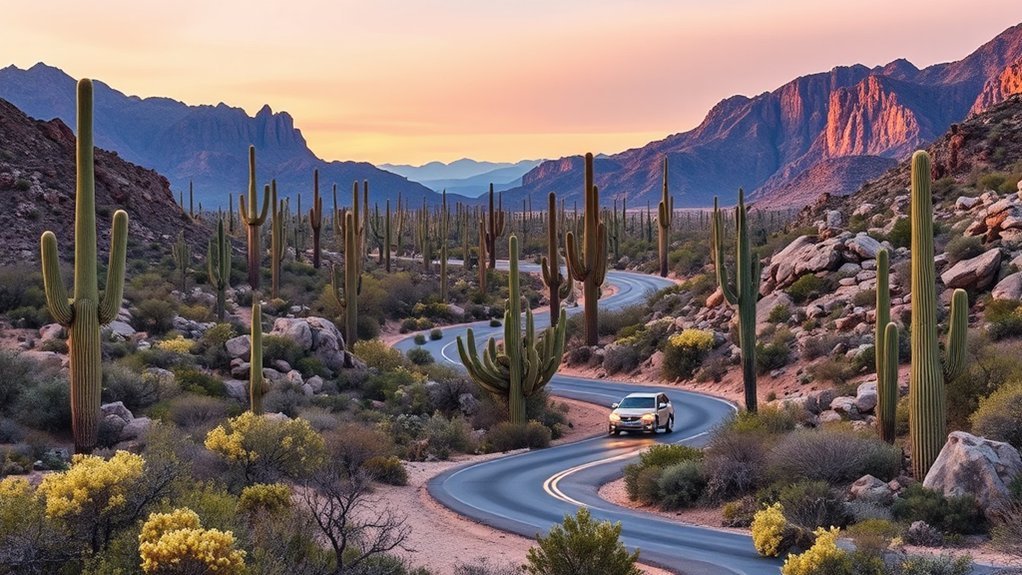
Start with Ajo Mountain Drive if you want a 21-mile loop rich in plant diversity, pullouts, and interpretive signs that make stops informative. For a longer, more remote experience, take Puerto Blanco Drive—41 miles into the mountains with dramatic desert views, but note some sections need high-clearance or 4WD. Pick up the guidebook at Kris Eggle Visitor Center for maps, seasonal highlights (March wildflowers, May–June cactus blooms), and wildlife-spotting tips.
Ajo Mountain Drive
Drive the 21-mile Ajo Mountain loop to experience Organ Pipe’s diverse flora and sweeping desert landscapes, with multiple pullouts and interpretive signs that explain the ecosystem and wildlife you’ll see. You’ll follow Ajo Mountain Drive, a scenic loop through Organ Pipe Cactus National Monument that offers Ajo Mountain views and stops explaining plants, animals, and geology. Standard vehicles can manage most of the route, though high clearance or 4WD helps you explore rougher sections. Visit in March for wildflowers or May–June for organ pipe blooms. Pick up the guidebook at the Kris Eggle Visitor Center to deepen your understanding and plan stops.
- Pullouts with interpretive signs
- Best months: March, May–June
- Vehicle and access notes
Puerto Blanco Drive
Although the full 41-mile Puerto Blanco Drive winds through rugged desert and volcanic ridges, you’ll be rewarded with dramatic vistas, diverse plant communities, and plentiful pullouts with interpretive signs that make it ideal for photography and natural-history observation. As a visitor, you’ll follow a scenic route through the Puerto Blanco Mountains where diverse vegetation and striking geology frame every mile. Many pullouts offer interpretive panels explaining local flora and fauna and point you to prime photo opportunities; spring brings the best wildflower and cactus blooms. Note that portions of Puerto Blanco Drive can be rough—high-clearance or 4-wheel-drive vehicles are recommended. Plan sufficient time, carry water, and check conditions before heading out for a safe, informative excursion.
Hiking Trails and Preparation Tips
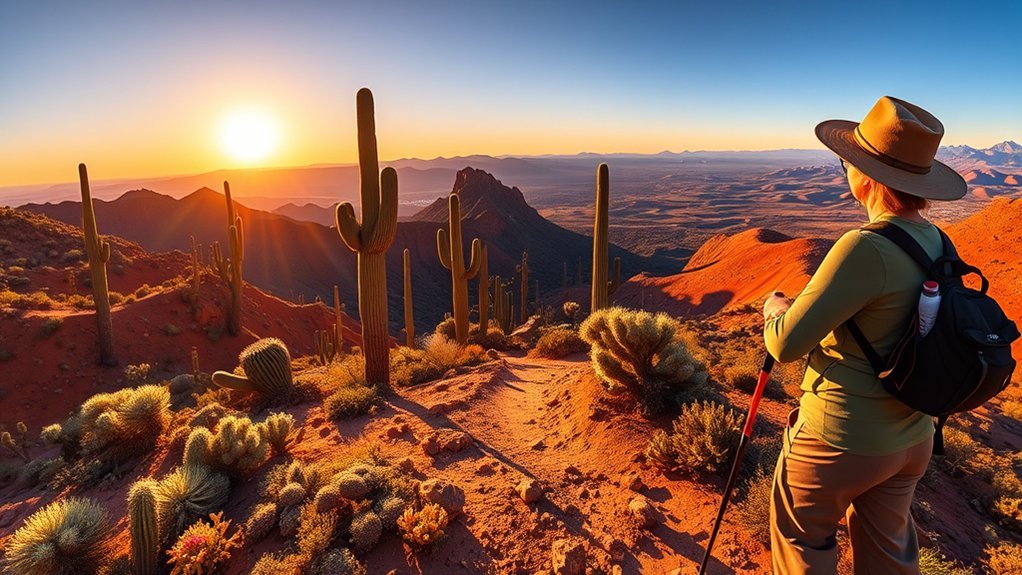
When you set out on Organ Pipe Cactus trails, plan for remote desert conditions and choose routes that match your fitness and experience—options range from the strenuous, 3-mile Bull Pasture Loop with steep grades and panoramic views to the easy, 1-mile Desert View Trail along the Ajo ridgeline. You’ll find clear preparation tips at the Kris Eggle visitor center; rangers will advise on trail conditions, maps, and seasonal hazards. Carry ample water, snacks, sun protection, and wear sturdy footwear. Consider the Hike for Health program if you’re aiming for longer distances and a certificate.
Plan desert hikes at Organ Pipe Cactus: choose routes to match fitness, check with rangers, and pack water.
- Check in at the visitor center for maps and alerts.
- Pack water, layered clothing, sun protection, and food.
- Match trail choice to experience; avoid hiking alone in heat.
Wildlife, Plants, and Notable Natural Features
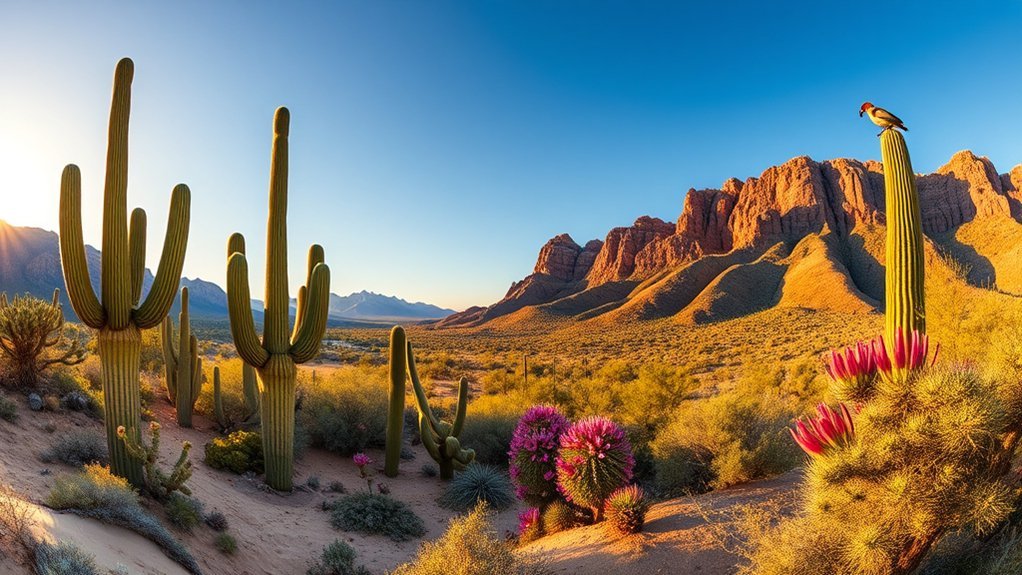
After you’ve picked a trail and packed for the desert, look up from the path to appreciate the monument’s living and geological treasures. You’ll find over 2,000 plant species centered on the organ pipe cactus, which can reach 25 feet and live 150+ years. Southern Arizona’s biodiversity includes 300+ birds, 100 reptiles and amphibians, and mammals like desert bighorn sheep and coyotes. In summer, organ pipe fruit ripens and draws pollinators such as the endangered Lesser Long-nosed Bat and other wildlife. Expect chollas, barrel cacti, and prickly pears framed by volcano-shaped mountains and broad washes. The park’s remoteness gives you dark skies for stargazing, letting you connect nocturnally with the desert ecosystem.
Visiting Ajo and Nearby Services
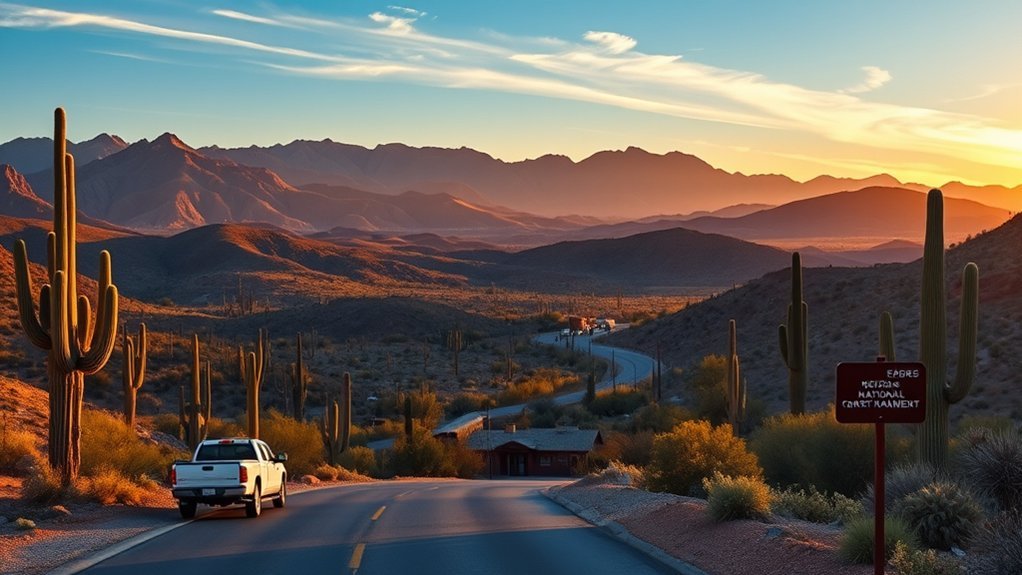
Looking for a nearby basecamp? Ajo, 30 minutes north of Organ Pipe Cactus National Monument, offers small-town charm and practical services so you can stay close to the park. You’ll find lodging, restaurants, and grocery stores to stock up before or after hikes and scenic drives. Ajo’s street art and historic sites are worth a short detour.
Ajo, 30 minutes north of Organ Pipe, offers lodging, groceries, and charming art—an easy basecamp for park adventures.
- Stay: Choose from modest lodging options that keep you near trailheads and visitor services.
- Stock up: Use grocery stores and restaurants in Ajo for fuel, supplies, and local meals before monument excursions.
- Explore: Combine park activities with Ajo’s art installations and scenic drives; Tucson is about 130 miles away for added amenities.
Frequently Asked Questions
Are Pets Allowed on Trails and in the Monument?
Yes — you can bring pets, but pet regulations require they stay leashed and under control; pet friendly areas are limited, trail restrictions prohibit pets on some routes, and you’ll respect wildlife considerations to protect habitat and safety.
Is Cell Phone Service Available Inside the Monument?
Mostly no — cell service coverage is spotty, like a flickering campfire; mobile data and network reliability vary, so you shouldn’t rely on them. Carry alternative emergency communication (satellite messenger or PLB) for safety.
Are There Guided Tours or Ranger-Led Programs Available?
Yes — you can join guided tour options and ranger programs; check the ranger programs schedule for times. You’ll get an interpretive activities overview and find educational workshops available to deepen habitat, wildlife, and cultural understanding.
Can I Bring Drones or Fly Model Aircraft Here?
No — you can’t fly drones or model aircraft here; park drone regulations and flying restrictions prohibit them. You’ll follow photography guidelines for handheld work, and rangers’ll enforce rules to protect wildlife and visitor safety.
What Accessibility Options Exist for Visitors With Mobility Impairments?
You’ll find wheelchair access at key facilities, accessible trails for short loops, visitor services offering information and assistance, and recommendations for mobility aids; staff can help plan routes and accommodations to suit your needs efficiently.
Conclusion
You’ll find Organ Pipe Cactus National Monument spans 516 square miles of Sonoran Desert, so plan for long drives and remote conditions. Visit December–March for mild weather and lower risks. Expect to see rare organ pipe cacti and over 560 recorded bird species, a statistic that highlights the area’s biodiversity. Bring water, sun protection, and reliable maps. Use campgrounds and Ajo services for supplies, and enjoy scenic drives and established trails responsibly.

